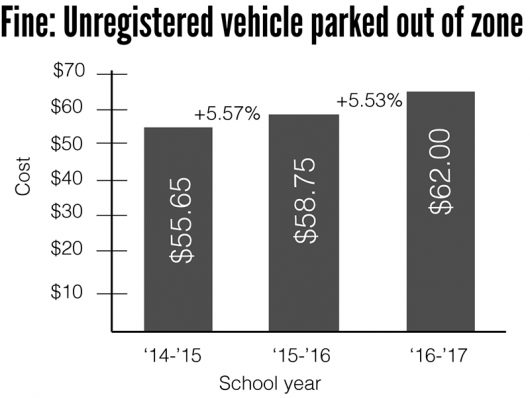
Source: Ohio State data. Credit: Eileen McClory | Assistant Design Editor
When Ohio State and CampusParc struck a blockbuster deal to privatize parking operations, the private investment company agreed to terms setting the percentage it could increase prices and fines each academic year.
Pricing data released by the university show in each of the last five years the company regularly met, or in some instances exceeded, the 5.5 percent annual increase initially agreed to in the contract signed five years ago.
The most expensive student pass, CG, went on sale in July for $858.48 for a year-long pass. Last year the same pass was $813.52, and in 2012 it cost $693.
According to documents detailing parking pricing for each year since the 2012-13 school year — when CampusParc was awarded access to OSU’s parking in a $483 million, 50-year deal — prices have increased each year in almost every category available to students, faculty and staff.
The only variation to this was between the 2013-14 and 2014-15 academic year, when one pass, the West Campus E pass stayed the same, at $299.52.
Parking passes are not the only areas where CampusParc has increased prices — rates for parking violation fines and garage use have also increased over the five-year period, according to the documents.
The terms of the contract with CampusParc, owned by Australian investment firm QIC, set price increases at 5.5 percent, per year, for the first 10 years. After 10 years, prices are set at either a 4 percent or a rolling five-year average of inflation, whichever is greater.
Examining parking prices, fines, garage prices and lot prices, garage prices are the only area where there have been increases above the set 5.5 percent. Any proposed changes outside that amount require university approval, Dan Hedman, spokesman for OSU’s Office of Administration and Planning, said in an email.
Increases in garage rates tallied between 5.9 and 8.7 percent except for the rate for the first 30 minutes.
David Hoover, communications director for CampusParc, said in an email that it was “very unlikely” parking-pass rates would not increase to the 5.5-percent level every year, but also emphasized that it was a measure considered when making the deal. He pointed out the $23.6 million already invested in maintenance and improvement for lots and garages.
While price increases are essentially guaranteed, they are also constant from year-to-year — which OSU argues is a benefit.
Between 2004 and 2013, students would have been better off under the university-managed system, OSU data shows. Rates were raised 5 percent each year between 2004 and 2009, 3 percent in 2010, and 5 percent each year again between 2011 and 2013.
But before that, however, from 1999 to 2003, prices fluctuated much less predictably, and at much higher rates. 1999 saw a 25 percent increase, for example, and prices increased each year at rates between nine and 20 percent.
Hedman said the agreement allows permit rates to increase annually under university-set caps.
“These caps are lower than the historical trend,” he said.
Hedman also pointed out that the average compound rate of increases for the years under the university-managed system was 7.5 percent, and prices fluctuated based on operations and project costs for the parking system.
Parking passes
But what does a 5.5 percent increase mean in dollars?
The biggest increase is seen in the departmental reserved parking space, which has gone up more than $300 since 2012, and almost $100 since last year. For sale this year for $1,873, it cost $1,512 during Campus Parc’s first year on campus.
The faculty A pass — the most expensive of the 17 passes available to faculty, staff and students, which vary in how close to campus they are and whether or not they’re in a lot or a garage — went on sale in July for $936.48 for the year. That compares to $887.76 last year, and $756 in 2012.
Data from 1999 to 2011 did not break down parking pass prices individually.
Range of parking price passes over the years
Prices do not tell the whole story, however — new parking passes have been created as well. A Lantern story from 2014 detailed the creation of a new faculty pass being created, by an agreement between the university and CampusParc, called the WAE.
According to the story, faculty and administrative personnel who bought the WA permit in 2013 — which allowed West Campus surface-lot access and limited garage access — had to buy the WAE if they wanted to keep the limited garage access, but at a price increase of 50 percent.
A WA pass cost $207 at the time, and currently goes for $243. But a WAE pass cost $315.96 at its introduction, and currently fetches $351.48. A pass covering those same privileges in 2012 cost $196.20.

Source: Ohio State data. Credit: Lee McClory | Assistant Design Editor
Fines
Parking passes are not the only increase. Every fine associated with parking infractions has increased at or near 5.5 percent since CampusParc took over parking operations as well. The university data from 1999 to 2013, which represented parking pass prices, did not include fines, garage access or surface lots.
The largest fine of the 19 listed, illegally parking in a wheelchair accessible parking space was $250 in 2012 — now the fine is $309.75. “Unauthorized use of a Parking Permit” also clocks in at $309.75, originally $250, and “Impound – Refusal to Obey Officer’s Directions” is listed at $223, originally $180.
Correction, 8/25: An earlier version of this story misspelled David Hoover’s name.


